Sharon Bader
Having ski toured for twenty years I know the most important thing in your gear inventory is your boots, closely followed by a flashy jacket. Even when I was a telemark skier I’d buy the stiffest boot I could afford. Forget those three buckled leather and lace jobs — I was STOKED when Scarpa came out with the plastic T2! OMG Control! Since then I’ve upped my ante when it comes to control by switching to alpine touring and the superior performance of AT gear. Thus, when it came time for an AT ski boot upgrade I was excited that Scarpa has now come out with a lighter, stiffer four buckle boot that fits my feet: The Gea.
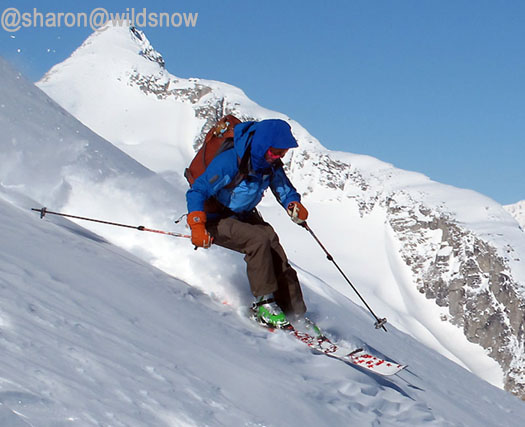
Sharon backcountry skiing the Scarpa Gea boot. You can't miss the glowing green lower shell.
New for Fall 2010/Winter 2011, Scarpa Gea is said to be the lightest four buckle women’s AT boot on the market (2 pounds, 15 ounces, women’s size 25). Not only are these shoes light, but Scarpa’s Alpine Axial Tongue design combines the benefits of tongue and overlap construction to provide stiffness and a progressive flex, along with ease of entry and exit.
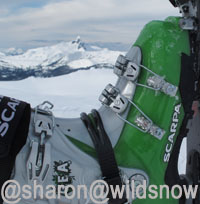
Scapa Gea backcountry skiing boots.
Gea backcountry skiing boot also shares the following characteristics with other boots in the Scarpa line up:
• Contemporaneous plant based (rather than carboniferous petroleum based) Pebax Rnew plastic.
• Ultra lightweight and super strong magnesium buckles.
• Quick Step-In tech fittings and Fitting Indicator System combine to make getting in and out of tech bindings easier than ever.
• Wiregate Tour lock buckle clasp keeps buckles in place for rapid uphill/downhill transitions.
• Asymmetric tongue provides precise power transmission.
• Wide range cuff motion translates to comfortable touring.
• Comes stock with Intuition Pro Flex G liner, state of art.
• New “Active Power Strap” saves some weight but still provides power.
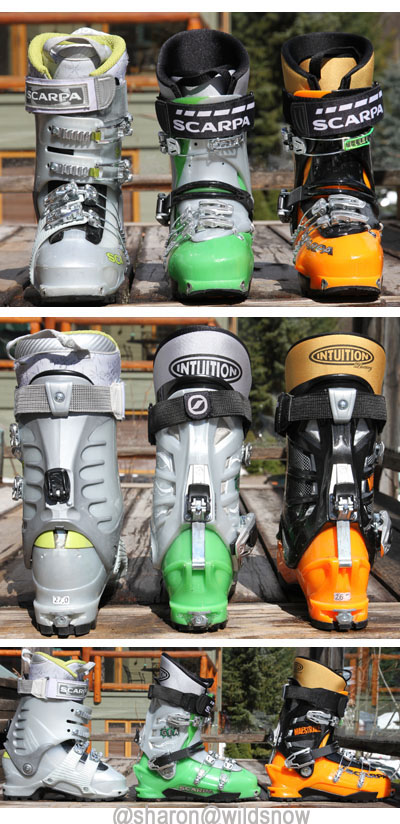
Comparison of the Gea (Center) with the Scarpa Shaka (left) and Scarpa Maestrale (right). Note the Maestrale and Gea are less beefy then the Shaka, but all have similar cuff heights. Interestingly the Shaka has a manufacturer claimed flex index of 110 and weighs 3lbs 10oz, vs 100 flex or the same sized Gea which weighs 3lbs. Shaka's are noticeably stiffer touring, and offer greater support for nasty chunder descending.
Scarpa’s Alpine Axial Tongue
Developed in 2010 as a variation of Scarpa’s cabrio (tongue shell) construction, with a twisting tongue (the tongue opens to the side), Axial tongue integrates the best attributes of both overlap and cabrio constructions. The asymmetrical tongue has perforations at the top to reduce weight and a cut out with a softer insert for increased flex at the crease (see photo below). The instep buckle which tightens over the crease is effective at reducing boot volume, a characteristic missing in most four buckle backcountry skiing boots (resulting in the not uncommon boot mod of moving the instep buckle aft). The shell tongue is also designed to facilitate motion and create an even flex to the boot.
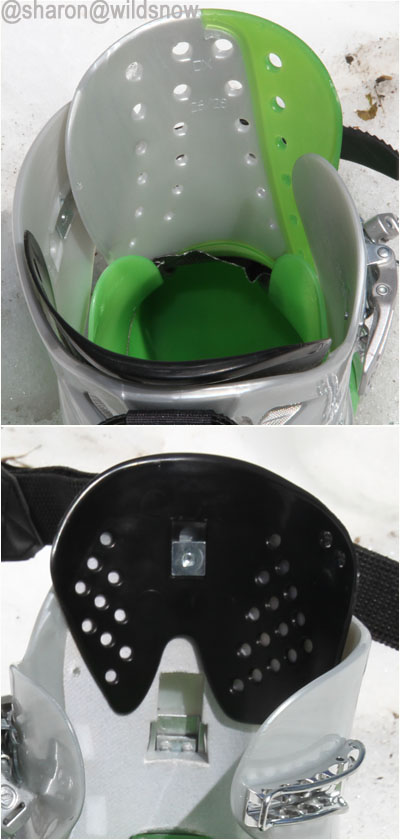
Gea cuff and tongue. The back of the cuff has an asymmetrical black spoiler for added stiffness and support.
The top of the Gea shell covered by the tongue is not composed of Pebax, but a lighter flexible material to keep snow out. For weight savings, Gea does not come with a footbed. This along with the Scarpa/Intuition liner, which has a thinner sole, allows consumers to use their own footbed if desired, or simply mold without and let the liner play the role of footbed. Note also the shell rivets are inset to prevent wear on the liners and a waterproof membrane covers the vents in the back cuff to prevent snow from entering and allow for increased breathability.
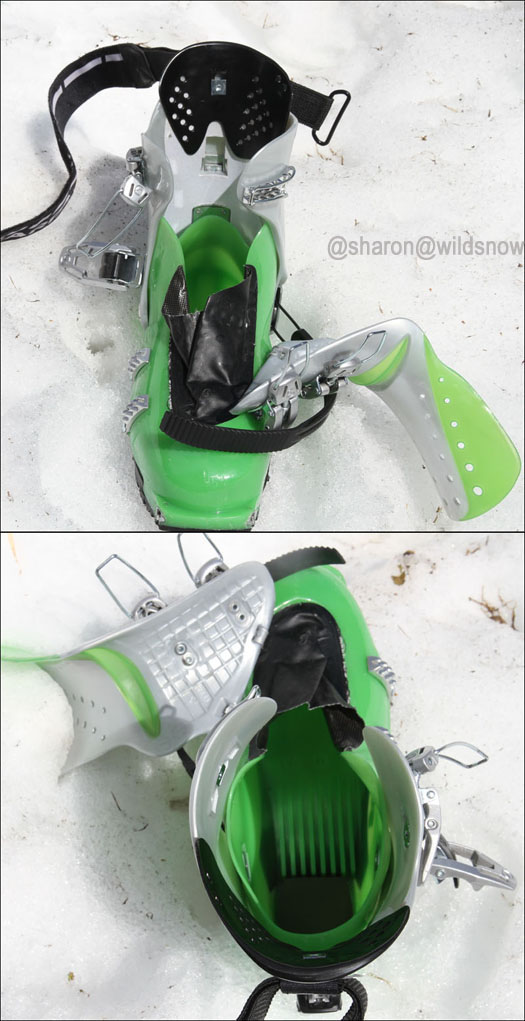
Gea, backcountry skiing boot shell.
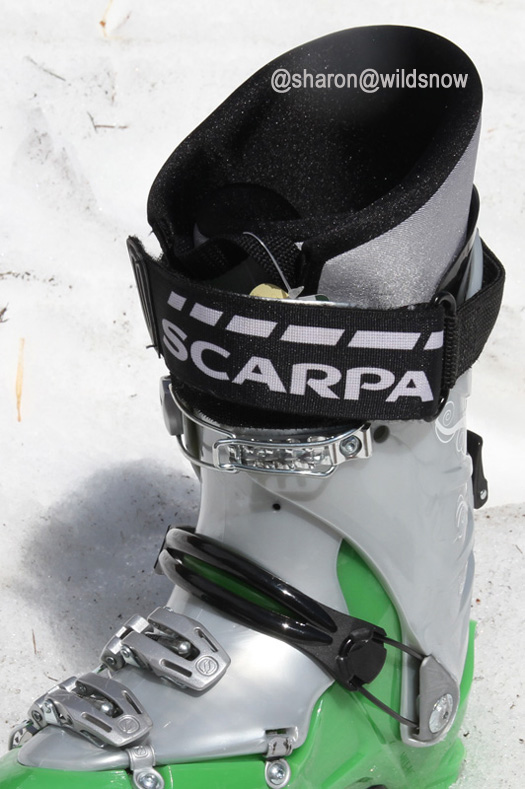
The impressive looking Active Power strap on the Gea is wide, lighter then the Scarpa Booster Strap and adds support to the upper cuff depending on how tight you yard on it. Also note the top buckle with the Wiregate Tourlock buckle, and the ratcheting instep buckle which covers the flexible insert of the tongue.
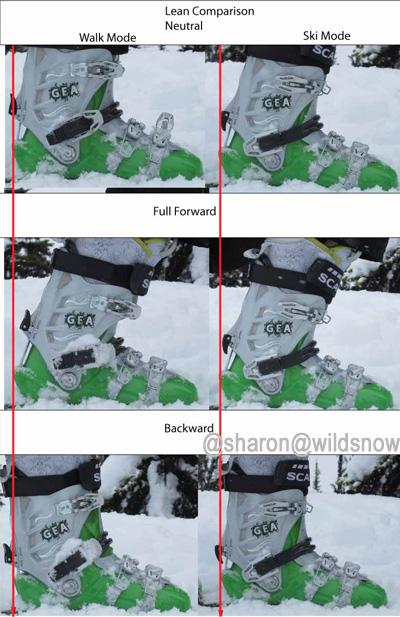
Comparison of lean in walk and ski mode. 39 degrees of cuff range and 24 degree backward from vertical in walk mode. Gea is super flexible in walk mode, yet converts to a very supportive downhill mode.
Gea is fitted out with the Intuition Pro Flex G liner (similar to Intuition’s Luxury Liner), which can be heat molded for ideal fit. These are some of the lightest and warmest performance liners available and offer an amazing combo of support, warmth, comfort and quick drying after a day of sweating on the slopes. Intuition liners’ dual density also adds stiffness and flex where needed. This particular liner has a removable tongue allowing you to add a stiffer tongue if so desired.
All the above praises aside, I prefer the Intuition Freeride liner so after a few tours I replaced the Pro Flex liner with the Intuition Freeride. Such is life for boot companies — pesky Wildsnowers are always figuring out some mod (grin). As we advocate here on WildSnow, don’t hesitate to factor the possibility of an aftermarket liner into any boot purchase. Just as not every boot shell fits every skier, neither does every liner.
Touring
This light comfortable boot made those long days easy. In all conditions the Gea was supportive, warm when it was really cold ( -30 C) and easily vented when it warmed up. Fully unbuckled it was very free. For the most comfort I did have to loosen the Active Power straps during longer tours, but that’s pretty normal with any boot.
Very little on the downside for this product. My only gripe being that the tongue on my testers lacked durability where it attaches to the hinges on the shell.
A tiny catch system on the cuff buckle, “Wiregate Tour Lock” kept the open buckle in place. This was a cool feature to keep the buckle in the semi-closed position. Conversely, this makes the buckles a bit cumbersome to detach when it’s time to take your boots off. To release the Wiregate, I would have to fully tighten the power strap to release pressure and create enough room to remove the clasp. The instep ratchet buckle I remember from my old Telemark T2 boots are easy to adjust. One drawback with this mechanism is that if you are always tightening in the same groove it does get worn after awhile. As for clicking into my tech bindings, the Dynafit Quick Step-In tech fittings and associated marks did make it easier to line things up for an easy “snap” — nice touch.
Downhill mode
I tested the size 27 Gea. My shoe size is between women’s 9 and 10. Scarpas size 26 is for a size 10 foot, size 27 is for a 11 foot. I was more comfortable in the larger boot. I found the liner in these boots would bunch on the top of my foot. I’m not sure why and would have to pull the liner tongue up when it bunched too much. The Intuition Freeride liner I swapped in did not have this problem.
I used these boots with the Black Diamond Verdict ski (2007), G3 Tonic 185, 177, G3 Zen Oxide 185 and Movement Spark skis. The boot was able to drive all these skis effortlessly. I tightened the boots enough to get a snug feel. My foot did not move in the boot. Every foot movement transferred directly to the ski and the ski did not deflect in variable conditions so long as I kept my feet driving forward. When fully buckled this boot was very stiff and offered solid, consistent support in even grabby variable conditions.
While riding the Gea, I was able to ski confidently in powder, wind affected snow, and hard pack groomers. I found the boot confidence inspiring, comfortable and responsive in all conditions. It had a consistent feel that allowed me to stay in control.
On a longer ski-out traverse I had to put the boot in walk mode and loosen the buckles for the uphill sections and I still had enough stiffness to maintain control on the narrow variable ski track out. Even after backcountry skiing all day I could traverse out of areas with the buckles tight and the boot in walk mode for comfort while having little loss of control.
Yes, I’ll sing this boot’s praises — they deserve it.
(WildSnow real world weight: Test pair at WildSnow HQ, size 25.5, BSL 288, per boot, 49.3 oz/1398 grams, shell without liner 40.9 oz/1160 grams.)
Beyond our regular guest bloggers who have their own profiles, some of our one-timers end up being categorized under this generic profile. Once they do a few posts, we build a category. In any case, we sure appreciate ALL the WildSnow guest bloggers!

